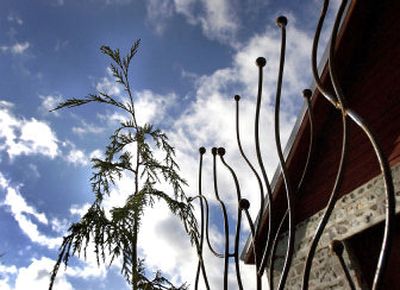Timeless beauty

Potted evergreens are a traditional way to add interest to the exterior of any house. Soon, we will be decorating inside our houses in preparation for the holidays. But why stop there? What about decorating outside, too?
Small evergreens are the stars of our outdoor holiday decor. A few of them gathered around a front entry or strategically placed outside a window and decorated with all-weather lights add a bright cheery welcome. They can even be brought indoors for short periods during the holidays.
Evergreen favorites
The best plants to use for container plantings are those that tend to grow slowly, have fairly upright, tight, growth habits and are hardy enough to survive in large containers through a winter. Here are a few to choose from:
Boxwood. Graham Blandy is a favorite evergreen shrub with small round, shiny leaves and a very tight upright growth habit that makes it perfect for small spaces and containers. It is a slow grower that grows to 6 to 8 feet tall and is relatively compact. Boxwood will grow in partial shade.
Holly. A holly with small, evergreen, dark green leaves and a very tight growth habit, “Sky Pencil” grows slowly to 6 to 8 feet tall and 1 foot wide. The blue hollies including “Blue Boy” and “Blue Girl” are moderate growers that can be kept trimmed to a desired shape. Since hollies come as male and female plants, you must have one of each to get the red berries. All hollies benefit from protection from cold winds.
Alberta spruce. One of the best and easiest container evergreens around, Alberta spruce are medium green conifers that grow to 6 feet tall in a very tight conical shape. Often they are trimmed into spirals and other shapes that add interest. “Jean’s Dilly” is a dwarf variety that works well in small spaces and as a short-term indoor plant.
Rocky Mountain junipers. If you like icy blue evergreen foliage, check out this group of plants. They do get large over time so this is one to enjoy in a container for a few years and then move into the garden. “Wichita Blue” has a tight upright conical shape and grows at a moderate rate. “Medora” is a slow grower that can get 10 feet tall and 21/2 feet wide with blue-green foliage. “Skyrocket” is a stately blue-green plant that grows quickly to 15 feet tall but only 2 to 3 feet wide.
Arborvitae or eastern red cedar. Small-sized plants of this common hedging material will work in containers for a couple of years before they need to be moved to the garden. “Degroot’s Spire” however is a medium green upright plant that grows slowly to 6 feet tall and 1 foot wide. Weeping Alaskan Cedar is another good choice.
Planting tips
Use a quality plastic or hard-fired ceramic (no terra cotta) container that won’t absorb water. It needs to be at least 16 inches in diameter to stand up to the freeze-thaw cycles, which can break roots and kill the plant. Pots must have drain holes to empty excess water from rain and snow. Use quality potting mixes. Be sure to water containers regularly, especially if they are under porches or eves.
Bringing potted evergreens indoors
Living trees can’t be kept in the house for long periods like cut trees. “Ten days maximum in the house,” says Nancy Williamson, nursery manager at Stanek’s on Spokane’s South Hill.
If left in a warm house too long, the trees begin to break out of dormancy; a process that can’t be reversed and could kill the tree once it is put back outdoors.
Transition the plant into the house by putting it in a garage for two to three days first and then reverse the process to put it back outside.
While indoors, place the plant in a cool space where it can get good bright light away from furnace vents and fireplaces. You might want to consider using the new cool LED lights to protect the needles. Water the plant lightly every day by placing a tray of ice cubes on top of the root ball. “The water doesn’t rush right through, and it does a slow melt and doesn’t get water all over the place,” says Williamson.
After the holidays
Move all outdoor container plants out where they can get indirect, but bright light and are open to the rain and snow. Provide some protection from winter winds. If you want to plant the tree in your garden after the holidays, dig the hole now and store the fill dirt somewhere where it won’t freeze until you are ready to plant.